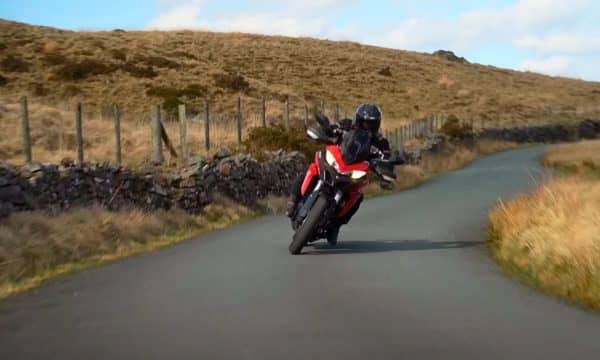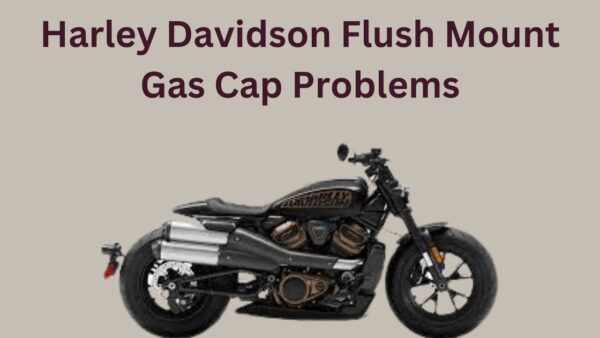The Ducati Multistrada 950 is a bike that promises adventure, but even the best journeys have bumps along the way.

However, just like any complex piece of machinery, it can sometimes face issues.
In this guide, we’re going to look closely at some common problems that Multistrada 950 owners are facing.
Let’s begin!
Ducati Multistrada 950 Problems
Ducati Multistrada 950 problems are gearbox downshift problems, seating, fuel gauge, uncertain fuel consumption, side stand, faulty clutch system, and engine overheating issues.
1. Gearbox Downshift Problem
Owners of the Ducati Multistrada 950 may encounter difficulties when downshifting gears, particularly from higher to lower gears.
This issue can manifest as resistance in the gear lever or a failure to fully engage the selected lower gear.
One reason for this problem could be inadequate clutch release, which prevents the gears from smoothly transitioning.
Another possibility is that the gearbox oil is aged or at an incorrect level, affecting gear shifting quality.
To resolve this problem you should check the motorcycle’s clutch system for proper operation and adjustment.
If the clutch is functioning correctly, inspecting and, if necessary, changing the gearbox oil could solve the issue.
You should also ensure that the oil is at the manufacturer-recommended level and grade is crucial.
You should also check for signs of wear or damage to the gearbox components and replace them as needed.
2. Seating Problem
The issue often stems from the seat’s firmness and ergonomics, which may not suit every body type.
Over extended periods on the road, this discomfort can transform into a significant annoyance, detracting from the otherwise exhilarating experience of riding.
To resolve this you should first consider purchasing an aftermarket seat, designed with additional cushioning and improved contours to better accommodate the rider’s form.
You can also add a gel seat cover or a padded cushion, which offers a simpler and more cost-effective improvement.
On the other consider the seat height, if possible, which may also help in finding a more comfortable riding position.
These modifications will enhance the overall riding pleasure by providing additional support and comfort.
3. Fuel Gauge Problem
This can be particularly troublesome, as it may lead riders to believe they have more gas than they actually do, potentially leaving them stranded.
A common cause for this is a malfunctioning fuel sensor, which may give erroneous readings.
To resolve this, you can first try resetting the motorcycle’s battery by disconnecting it for a few minutes.
If the problem persists, you should recalibrate the fuel sensor using the motorcycle’s onboard diagnostic system.
If you’re tech-savvy and comfortable with motorcycle maintenance, referring to the Multistrada’s service manual could guide you through the recalibration process.
If neither of these steps rectifies the issue, you can replace the fuel sensor, which can resolve the fuel gauge problem.
4. Uncertain Fuel Consumption
This varying fuel consumption could be due to riding habits, inconsistent fuel quality, or discrepancies in the bike’s fuel management system.
To address this, you should monitor your riding patterns and elect steady speeds when possible.
On the other hand consistently maintaining motorcycles, such as ensuring the fuel injectors and filters are clean, can help in better predicting fuel usage.
Related: Ducati Panigale V2 Problems
You can also use higher-quality fuel and keep the bike in optimal condition through regular servicing.
5. Side Stand Issues
Some owners have reported problems with the side stand, including instances where it may be too short or not sturdy enough, causing stability concerns when parking the motorcycle.
The issue seems to arise from the design that does not adequately support the bike’s weight and size when positioned on uneven surfaces or loaded with gear.
In this situation, you can opt for an aftermarket side stand that is longer and provides a more substantial base.
Also, you can install a larger footplate that can improve the side stand’s grip and stability on various terrains.
Always ensure that the side stand is deployed on solid ground and be mindful of how you park your Multistrada to prevent tipping.
6. Faulty Clutch System
The faulty clutch system could manifest as difficulty in gear shifting or an unusual stiffness when pressing the clutch lever.
This problem often arises due to premature wear of the clutch plates or a malfunctioning clutch cable.
Sometimes prolonged use, aggressive riding habits, or lack of proper maintenance can all contribute to this wear and tear.
To resolve this you should inspect the clutch cable for any signs of damage or excessive tension and adjust if necessary.
If the problem persists, you should examine and replace the worn clutch plates to restore the bike’s smooth gear transitions.
However, regular maintenance and gentle handling of the clutch mechanism can help prevent this issue from reoccurring.
7. Engine Overheating
This issue often arises during long rides, especially in high-temperature conditions or when the bike is idling for extended periods in traffic.
It can stem from a variety of reasons such as a low coolant level, a malfunctioning radiator fan, or clogged cooling channels within the engine.
To prevent your Multistrada 950 from overheating, you should regularly check the coolant levels and top up as necessary.
Also, ensuring that the radiator is clean and unobstructed allows for proper airflow, essential for cooling.
Moreover, you can keep an eye on the fan’s functionality to save you from potential overheating troubles.
If you notice that your engine temperature is consistently running high, inspecting these areas and performing routine maintenance can help nip the problem in the bud.
If the issue persists, the cooling system might need a more thorough examination or possible parts replacement.
8. Front Brake Disc Warping
This issue might arise from the disc being exposed to excessive heat, which can occur during prolonged periods of braking or due to frequent hard stopping.
Such heat can cause the metal to warp, losing its flat shape, and thereby compromising the braking performance.
The causes for warp could include aggressive riding habits, overloading the bike, or simply the natural wear and tear over time.
To prevent this, you can adopt smoother braking habits, avoid carrying unnecessary weight and regularly check your brake discs for signs of stress.
If you notice signs of warping, you should inspect and replace the disc, if necessary. Moreover, use high-quality brake discs and ensure they are correctly installed.
9. Fork Seal Failures
The fork seals are crucial because they keep the oil inside the motorcycle’s front suspension.
When these seals break or wear out, you might notice oil leaking down the forks, which can reduce the suspension performance.
This problem can occur due to regular wear and tear, exposure to dirt and debris, or the impact of continuous rough riding.
To resolve this you should do regular checks and clean the area around the fork seals to prevent dirt buildup that can damage the seals.
Also, using a fork seal cleaner tool can help remove any debris caught in the seals without disassembling the fork.
If the problem persists or the seals are visibly damaged, they will likely need to be replaced.
This is a task that can be done at home with some motorcycle maintenance knowledge and the right tools.
Is Ducati Multistrada 950 Reliable
Yes, the Ducati Multistrada 950 is known for its reliability. As a versatile adventure motorcycle, it combines Ducati’s performance-oriented engineering with the robustness needed for varied terrains.
Owners report satisfaction with its durability over long distances and minimal maintenance issues when serviced regularly.
Ducati Multistrada 950 User Review
The Ducati Multistrada 950 has gained acclaim as one of the top all-round motorcycles in the industry. It inherits the outstanding qualities of its larger counterpart, the Multistrada 1200 while offering a less intimidating power output, simpler specifications, and a more accessible price point.
Notably, the Multistrada 950 stands out for its impressive service intervals and the remarkable level of equipment it provides within its price range.
Riders appreciate its comfortable ride, thanks to fully adjustable suspension, although it may lack some support for aggressive riding compared to the 1200.
The 937cc engine, derived from the Hypermotard, offers a smooth ride with 113bhp and 71ftlb of torque, although some riders may find it less thrilling in sports mode.
The bike boasts high build quality and reliability, with top-notch components such as Brembo brakes and Bosch electronics.
It initially stood out as a great value proposition, particularly when compared to the pricier 1200 models.
Despite its lower price, the Multistrada 950 comes well-equipped with multiple rider modes, adjustable suspension, and the Ducati Safety Pack.
Ducati Multistrada 950 Technical Specifications
| Specification | Detail |
| Engine Type | Straight-cut gears, ratio 1.84 : 1 |
| Displacement | 937 cc (57.2 cu in) |
| Power | 83 kW (113 hp) @ 9,000 rpm |
| Torque | 96 Nm (71 lb-ft, 9.8 kgm) @ 7,750 rpm |
| Dry Weight | 204 kg (450 lb) |
| Seat Height | 840 mm (33.1 in), adjustable with accessories |
| Safety Equipment | Ducati Safety Pack: Bosch Cornering ABS, Ducati Traction Control (DTC), Riding Modes, Power Modes, Vehicle Hold Control (VHC) |
| Valve Adjustment | 30,000 km (18,000 miles) |
| Fuel Injection | Bosch electronic fuel injection system, Ø 53 mm throttle bodies with Ride-by-Wire system |
| Exhaust System | Stainless steel single muffler, Catalytic converter and 2 lambda probes |
| Gearbox | 6 speed with Ducati Quick Shift up/down (DQS) |
| Primary Drive | Slipper and self-servo wet multi-plate clutch with hydraulic control |
| Final Drive | Chain, Front sprocket Z15, Rear sprocket Z43 |
| Clutch | Fully adjustable, depending on the model |
| Frame | Tubular steel trellis frame |
| Front Suspension | Fully adjustable mono-shock, Remote spring preload adjustment, Aluminum double-sided swingarm |
| Rear Suspension | Fully adjustable monoshock, Remote spring preload adjustment, Aluminum double-sided swingarm |
| Front Brake | 2 x Ø 320 mm semi-floating discs, Radially mounted Brembo monobloc 4-piston 2-pad calipers, Radial Master Cylinder, Bosch Cornering ABS |
| Rear Brake | Ø 265 mm disc, 2-piston Brembo floating caliper, Bosch Cornering ABS |
| Wheelbase | 1,594 mm (62.8 in) |
| Front Tire | Pirelli Scorpion Trail II 120/70 ZR 19 |
| Rear Tire | Pirelli Scorpion Trail II 170/60 ZR 17 |
| Wheel Travel | 170 mm / 170 mm (6.7 in / 6.7 in) Front/Rear |

Ahtsham Younas is a passionate blogger and content writer. He loves to ride motorcycles and learn the mechanical process behind the motorcycles.
He has been writing articles in the motorcycle industry since 2019 and has learned many things about motorbike niches.


